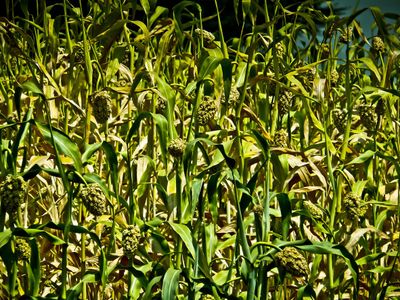What is Sudangrass?
Sudangrass (Sorghum bicolor) may grow from 4 to 7 feet (1 to 2 m.) in height and is grown as pasture, green manure, hay, or silage. When it is hybridized with sorghum, the plants are slightly smaller and easier to manage with superior high heat tolerance. In addition, sorghum sudangrass care is minimal, as the seed needs little moisture to germinate and the seedlings thrive in heat and low water regions. The biggest need for this versatile grass is at least 8 to 10 weeks of fine weather before harvest. Sorghum sudangrass has been shown to reduce weeds when planted thickly as well as suppress root nematodes. The plant has also been shown to be extremely efficient in water absorption with twice as many roots as corn but less leaf surface, which allows evaporation. It is also grown for its seed, as the grass is a prolific seeder, economically providing the next generation of the crop. Good soil management ensures future crops, prevents erosion, and is part of the ecological wheel of sustainability. Sudangrass cover crops are an essential part of soil management in many areas of North America and are widely used as one of the highest yielding forages too.
How to Grow Sudangrass
The best soil for sudangrass is warm, well-tilled, moist, and clod free. Fertility is not the most important consideration, as this grass requires little nitrogen; however, in heavily used lands, additional nitrogen will enhance its growth. Early seeding is important when growing sorghum sudangrass. Seed in warmer regions can be planted as early as February, but most of us must wait until the soil is evenly warmed to at least 60 degrees Fahrenheit (16 C.). A general rule of thumb is to seed July through August. The correct timing of planting is important if harvesting the entire plant, such as in the case of sudangrass cover crops. Till young plants under only as older plants create clumps that can be difficult to break down. Crops that are mowed for hay can be cut at 4 to 7 inches (10 to 18 cm.) to allow for recovery and another harvest.
Management of Sorghum Sudangrass
This grass is one of the easier varieties to manage. Early mowing is crucial to sorghum sudangrass care that is being used as forage since older leaves have lower protein content and become fibrous, thus harder to digest. The plant must be harvested at the vegetative stage, as it contains as much protein as mature alfalfa and can be harvested at least one more time, producing more usable products. Mow when plants are 20 to 30 inches (51 to 76 cm.) tall, leaving 6 inches (15 cm.) of stubble. Once late summer approaches, the entire plants should be tilled under to decompose and a suitable winter crop sown. Sudangrass is useful as a summer cover crop where a long mid-summer period is available.
